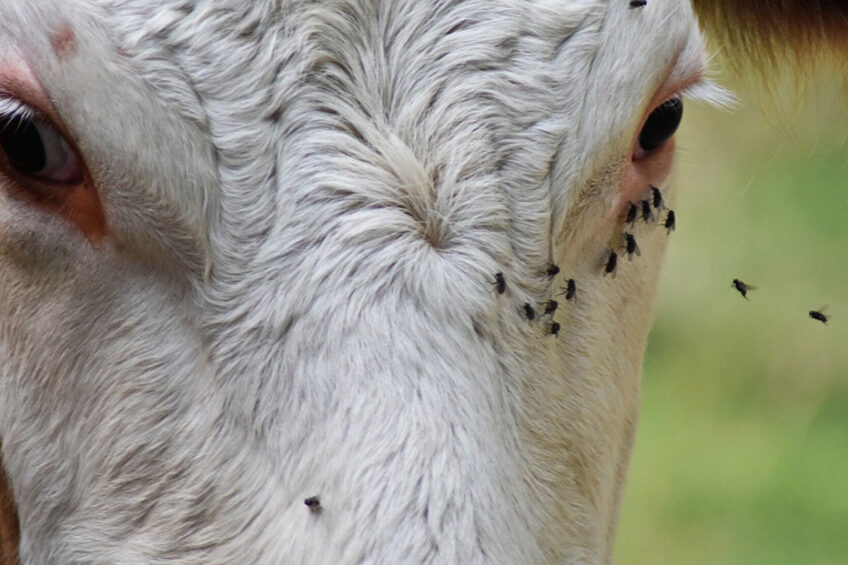Fly control solutions – what works for your farm?

Choosing the right fly control solution for your farm can be tricky. We highlight some different methods to help you pick the best solution for your operation.
House flies and stable flies are 2 of the most common fly species found on dairy farms, and they are a thorn in the side of many dairy farmers worldwide. Besides being a nuisance for farmers and their cattle, their presence is a stress factor for cows, curbing milk production. Furthermore, research shows that flies transmit a wide variety of livestock diseases, ranging from diarrhoea and mastitis to Rift Valley fever and Bluetongue. The presence of house flies or stable flies on a dairy farm is therefore not only stressful, it is also dangerous.
Flies affect the cows’ well-being and the farmer’s financial well-being, as their presence often leads to costly veterinary visits and reduced milk production. Getting rid of house flies and stable flies is a top priority for farmers, but implementing the right fly control solution can be a tricky task. In this article we discuss 6 solutions to help you choose the right approach for your farm.

Sanitation
The first step to successfully controlling and eradicating house flies and stable flies on a dairy farm is ensuring adequate sanitation is in place, as this removes fly breeding sites. Without sanitation, any further treatments – such as larvicides, described further below – may not have the desired effect or deliver long-term results.
Proper handling of manure is especially vital in the fly breeding season. Emeritus Professor at the University of Kentucky Lee Townsend argues that during the fly breeding season, manure should be removed from the barns, loafing sheds and calf pens at least twice a week to prevent fly breeding sites from popping up on your farm. The manure should be spread out thinly on crop land so that it can dry. If stored in liquid manure pits or lagoons, the manure should be agitated to prevent the breeding of rat-tailed maggots. Cleaning manure out of all the little nooks and crannies – from corners, around posts and under feed bunks – is necessary to prevent flies from breeding here.
Additionally, it is important to clean up rotting hay or straw, silage and other spilled feeds regularly and to repair leaking water troughs and plumbing when necessary.
Residual fly sprays and feed additives
In addition to proper sanitation on your dairy operation, residual fly sprays could help when battling adult flies. Prof Townsend argues that they should be applied to fly resting areas in loafing sheds and barns, as fly sprays used as space sprays, mists or fogs have no residual activity; that is, they will only eradicate the flies that are present at the moment of application. Another method of using residual fly control is through feed additives, which prevent the flies from breeding due to the larvicide present in the dairy cows’ manure.
One such feed additive is ClariFly Larvicide. This larvicide is added to the dairy cow’s feed rations to eradicate flies in their larval stage. According to the company, adding this ingredient to the feed ration is all the work an employee needs to do to reduce disease-carrying fly populations on an operation.
Kramp
offers a permethrin-based residual fly spray solution. In addition to eradicating house flies and stable flies, the product has a long-lasting effect against mosquitoes, mites and crawling vermin such as cockroaches and ants. When selecting a residual fly spray or a feed additive, make sure to check that it is approved and legal to use on your operation.
Larvicides
Previously mentioned as a feed additive, larvicides are an effective way to get rid of flies on your operation by targeting the early stages of their development. Larvicides provide a useful solution when sanitation and manure management measures cannot be used or are not efficient enough. When using larvicide, make sure to treat areas with large numbers of maggots, and do not spray animals with these solutions.
Lodi UKoffers Larvenol larvicide. Lodi UK states that the product, which contains S-Methoprene, is applied as a granule directly into the muck or areas where flies and maggots are breeding, adding that “Larvenol will ensure that the larvae can’t develop into adult flies and will control an infestation before it starts, targeting 80% of their lifecycle”.
As with residual fly sprays and feed additives, it is important to make sure your larvicide of choice complies with local laws and legislation.

Screening
Screening is a less invasive fly control solution than using residual fly sprays, feed additives or larvicides. Screening and other mechanical control methods prevent flies from entering the milk room and milking parlours. Screens come in a variety of shapes. Securing fine mesh screening over windows and ensuring any crevices are closed off prevents flies from entering the barn. Fans, too, are a useful addition to your fly control programme, as a downward and outward airflow makes it difficult for flies to enter the barn. Additionally, air curtains are useful in keeping flies out of the milk room and milking parlour.Berner air curtains are used on a dairy farm and come with an additional perk: using the air curtains keeps equipment from freezing up.
Fly traps
Fly traps, like screening and other mechanical control methods, are not as invasive as the use of residual fly sprays, feed additives or larvicides. Fly traps come in a variety of shapes and sizes and have the additional benefit of being suitable for outdoor use (in some cases). Though not eradicating flies at the source, they are a good way to get rid of existing populations. DeLaval provides a wide variety of fly trap products, ranging from fly bags to window fly traps, fly sheets, fly string and fly curtains. The fly bags are used outdoors and kill flies with a non-toxic bait, and the window fly traps are used in the barn. These glue traps use very strong, natural glue to catch the flies, and DeLaval states that the design of the trap “attracts flies even at dusk thanks to its 3-D pattern and colours”. The same goes for the fly sheets, fly string and fly curtains. In addition to products such as those offered by DeLaval, ultraviolet lights and bottle traps are used as non-invasive fly control measures.
Fly parasite programmes
In addition to using residual fly sprays, feed additives, larvicides, screening and fly traps, fly parasite programmes are used to treat areas infested by flies. Prof Townsend explains that several commercial firms offer fly parasite release programmes in which small wasp parasites lay eggs in the larvae or pupae of house flies. The benefits of such programmes have not yet been proven, and Prof Townsend urges that if you try them, including sanitation and chemical treatments will probably be essential.
Join 13,000+ subscribers
Subscribe to our newsletter to stay updated about all the need-to-know content in the dairy sector, two times a week.










